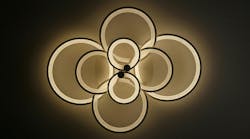Brett Andersen had his sights set on Broadway. While waiting to kickstart his career lighting productions at the heart of the theater world, he took what he considered a temporary gig uptown, as a draftsperson for Focus Lighting. Nearly three decades later, he is a principal designer at Focus and one of two partners, alongside founder Paul Gregory. Now Andersen is helping steer the New York firm into the future. Here, he explains how he made the transition from designer to business owner.
Impressions matter
After faxing in his résumé, Andersen went in for a daylong interview that culminated in an offer. The job, he said, came with two things he needed: “a salary and benefits.” He accepted the position.
Andersen advanced from drafting to junior designer, working on projects like the Mohegan Sun Casino and Le Cirque 2000. He began overseeing his own projects, such as the Mall of Millenia, in Orlando, and designing and programming the lighting controls for the Burj al Arab resort, in Dubai. “It was both exciting and terrifying,” he says, “to be trusted to go halfway around the world to program the largest control system we had ever designed for one of the most iconic buildings in the world.”
Focus also changed over time. When Andersen joined 27 years ago, the firm had 12 employees in a townhouse on West 101st Street. “Now there are 37 of us in a two-level converted retail building in Harlem,” he says. The upper floor is an open workspace while the downstairs houses a double-height light lab in which the team develops and tests design ideas.
Learning the business
In 2001, Gregory asked Andersen if he wanted to learn about the business side of lighting design. The firm was becoming too busy for Gregory to weigh in on every project, respond to every request for proposal (RFP), and manage the growing staff. Andersen hesitated at first. “My passion was designing, but I soon realized it was a good opportunity for me,” he says. “[Gregory] recognized that training a future partner would take time.”
As the team at Focus grew, one of its biggest challenges was scaling the company without losing the visual excitement that makes its projects successful. “Paul sat down and made a list of the 13 things he always did on every project,” Andersen says. “At first, that list was meant for just me and the six other principals, but now we share that list with everyone at Focus.”
Among Gregory’s checklist are the following:
- Answer the question, “Why will this project be great?”
- Have we mocked-up the new, difficult, or risky design elements?
- Have we thought about lighting maintenance after we leave?
- Are we talking to the client on a regular basis?
A core tenet at Focus has been that the best ideas rise to the top. “It doesn’t matter who you are within the company,” Andersen says. “If you have an idea, we want to hear it. If it’s a great idea, we want to find a way to make it happen.” This belief has created “an environment where everyone has an opportunity to show their creativity and feel like they’re contributing.”
Information share
Today, Andersen manages the firm’s everyday business operations while overseeing with the other principals more than 100 active projects, which include restaurants, hospitality, retail, residential, and exterior lighting, and collaborations with lighting artists. Firm associates and junior designers are divided into seven studios, each led by a senior designer. Each studio shepherds a project from the first meeting through to completion. “Our teams are passionate about seeing their hard work come alive in the end,” Andersen says. “This passion is a big reason why our projects are so successful.”
To keep everyone updated on industry advancements and Focus activities, Andersen leads semimonthly staff lunches to exchange technical information and design approaches and receive project updates. On alternate weeks, he meets with senior designers and principals to discuss new fixtures and controls, design ideas, and project issues.
Andersen identifies the firm’s six project managers as an internal asset. “So much of what we do as lighting designers today revolves around technology,” he says. “Our project management team helps keep our design studios informed of new advancements, reviews the technical aspects of our designs, and helps us navigate the construction process.”
Guardians of design
Andersen believes company culture sets Focus apart from other architectural lighting design firms. “We don’t just illuminate a space,” he says. “And we don’t just develop a creative concept. [O]ur responsibility is to be the guardian of the architect’s or interior designer’s vision.” A designer may struggle with seeing “how every form, finish, material, and color will be perceived once you combine them all with electric and natural light,” he explains. “Our clients rely on us to understand how they want the space to feel and be perceived, and then we help guide them to that goal.”
Focus takes designers and their material samples into its light lab to show them how everything looks once illuminated. “Seeing is believing,” Andersen says. “In our light lab, we have an array of different types of lighting fixtures and four full-functioning lighting control systems for testing.” The lab also includes a shop where the team can construct and illuminate architectural mock-ups. “Sometimes it looks great, but sometimes we have to tweak their choices for our lighting to get the intended result,” he adds. But the process “helps avoid unpleasant surprises down the road.”
Lookahead
Focus Lighting’s current project workload includes the Toptable restaurants in Whistler, British Columbia; Tree of Life Synagogue in Pittsburgh, with architect Daniel Libeskind; Virgin Hotel in Las Vegas, with Rockwell Group; Waldorf Astoria New York, with Skidmore, Owings & Merrill; and Liberty Science Center in Jersey City, N.J.









